航空运输企业核心竞争力各组成要素及其价值作用的分析研究
- 格式:docx
- 大小:19.71 KB
- 文档页数:6
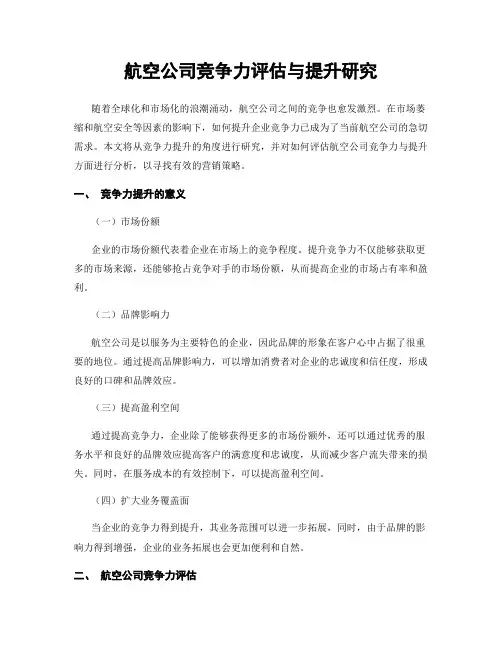
航空公司竞争力评估与提升研究随着全球化和市场化的浪潮涌动,航空公司之间的竞争也愈发激烈。
在市场萎缩和航空安全等因素的影响下,如何提升企业竞争力已成为了当前航空公司的急切需求。
本文将从竞争力提升的角度进行研究,并对如何评估航空公司竞争力与提升方面进行分析,以寻找有效的营销策略。
一、竞争力提升的意义(一)市场份额企业的市场份额代表着企业在市场上的竞争程度。
提升竞争力不仅能够获取更多的市场来源,还能够抢占竞争对手的市场份额,从而提高企业的市场占有率和盈利。
(二)品牌影响力航空公司是以服务为主要特色的企业,因此品牌的形象在客户心中占据了很重要的地位。
通过提高品牌影响力,可以增加消费者对企业的忠诚度和信任度,形成良好的口碑和品牌效应。
(三)提高盈利空间通过提高竞争力,企业除了能够获得更多的市场份额外,还可以通过优秀的服务水平和良好的品牌效应提高客户的满意度和忠诚度,从而减少客户流失带来的损失。
同时,在服务成本的有效控制下,可以提高盈利空间。
(四)扩大业务覆盖面当企业的竞争力得到提升,其业务范围可以进一步拓展,同时,由于品牌的影响力得到增强,企业的业务拓展也会更加便利和自然。
二、航空公司竞争力评估提升竞争力是一个长期而艰巨的过程,首先需要对企业的现有竞争力进行评估,及时发现存在的优点和薄弱点,制定相应的提升计划和策略。
以下是航空公司竞争力评估的主要方面:(一)服务水平航空公司以服务为主要特色,因此服务水平在竞争力评估中占据非常重要的地位。
通过对服务质量、流程和态度进行评估,可以发现是否有不足或瑕疵。
值得注意的是,服务水平的提高需要从企业内部文化、业务流程和员工素质等多个方面进行协调和推动。
(二)机队规模和配置航空业存在较高的行业门槛,因此机队规模和配置对提升企业竞争力也非常重要。
大型机和新型机的配置能够提升航空公司的整体形象和客户满意度,从而提高市场占有率。
(三)票务销售渠道票务销售渠道是航空公司获取客户和市场份额的重要途径,主要涉及到旅游公司合作、网络销售、旅行社代理等多个渠道。
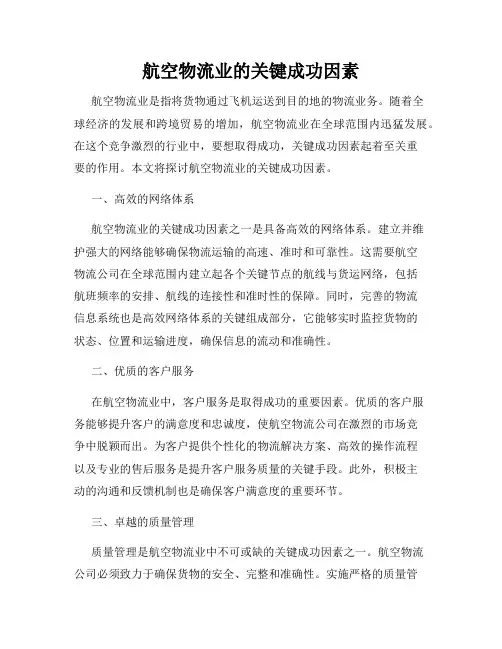
航空物流业的关键成功因素航空物流业是指将货物通过飞机运送到目的地的物流业务。
随着全球经济的发展和跨境贸易的增加,航空物流业在全球范围内迅猛发展。
在这个竞争激烈的行业中,要想取得成功,关键成功因素起着至关重要的作用。
本文将探讨航空物流业的关键成功因素。
一、高效的网络体系航空物流业的关键成功因素之一是具备高效的网络体系。
建立并维护强大的网络能够确保物流运输的高速、准时和可靠性。
这需要航空物流公司在全球范围内建立起各个关键节点的航线与货运网络,包括航班频率的安排、航线的连接性和准时性的保障。
同时,完善的物流信息系统也是高效网络体系的关键组成部分,它能够实时监控货物的状态、位置和运输进度,确保信息的流动和准确性。
二、优质的客户服务在航空物流业中,客户服务是取得成功的重要因素。
优质的客户服务能够提升客户的满意度和忠诚度,使航空物流公司在激烈的市场竞争中脱颖而出。
为客户提供个性化的物流解决方案、高效的操作流程以及专业的售后服务是提升客户服务质量的关键手段。
此外,积极主动的沟通和反馈机制也是确保客户满意度的重要环节。
三、卓越的质量管理质量管理是航空物流业中不可或缺的关键成功因素之一。
航空物流公司必须致力于确保货物的安全、完整和准确性。
实施严格的质量管理体系,包括合规性要求、保障飞行安全、拥有高素质的员工和先进的设备,能够有效地减少货物丢失或损坏的风险。
此外,为了确保操作的准确性和可靠性,监察和评估机制也是不可或缺的一部分。
四、合理的成本控制成本控制是航空物流业中取得成功的关键因素之一。
高昂的运营成本对于航空物流公司来说是一大挑战。
因此,航空物流公司需要通过不断优化运营流程、提高能效和降低运营成本来保持竞争优势。
采用先进的技术和仪器、有效的能源管理、合理的人员配置以及优化供应链管理等措施都能够有效控制成本,提高企业盈利能力。
五、灵活的应变能力在快速变化的市场环境中,航空物流业需要具备灵活的应变能力。
能够及时调整运力、航班频率和航线安排以应对市场需求的变化是取得成功的关键要素。
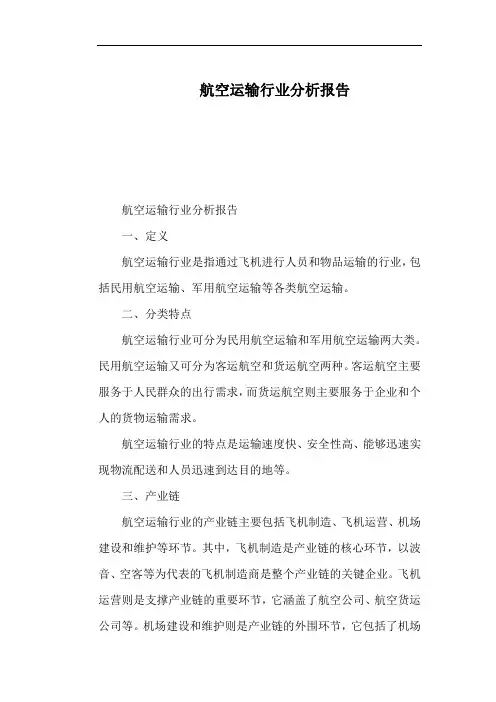
航空运输行业分析报告航空运输行业分析报告一、定义航空运输行业是指通过飞机进行人员和物品运输的行业,包括民用航空运输、军用航空运输等各类航空运输。
二、分类特点航空运输行业可分为民用航空运输和军用航空运输两大类。
民用航空运输又可分为客运航空和货运航空两种。
客运航空主要服务于人民群众的出行需求,而货运航空则主要服务于企业和个人的货物运输需求。
航空运输行业的特点是运输速度快、安全性高、能够迅速实现物流配送和人员迅速到达目的地等。
三、产业链航空运输行业的产业链主要包括飞机制造、飞机运营、机场建设和维护等环节。
其中,飞机制造是产业链的核心环节,以波音、空客等为代表的飞机制造商是整个产业链的关键企业。
飞机运营则是支撑产业链的重要环节,它涵盖了航空公司、航空货运公司等。
机场建设和维护则是产业链的外围环节,它包括了机场的建设、运行管理等。
四、发展历程航空运输行业的历史可以追溯到20世纪初的飞机发明以来。
但是,真正发展起来的时间是在第二次世界大战以后。
20世纪50年代,随着新一代民用喷气式飞机的出现,航空运输行业迎来了快速发展的新阶段。
随着经济全球化和国际化程度的不断提高,航空运输行业在21世纪依靠科技的进步和市场需求的推动,不断地发展壮大。
近年来,互联网、大数据、人工智能等新技术也被广泛应用于航空运输行业。
五、行业政策文件国家出台了多项相关政策文件,如《民用航空法》、《关于促进空中货运业发展的意见》、《中长期航空运输规划》等,为行业发展指明了方向。
六、经济环境近年来,随着中国经济的发展,航空运输业也得到了快速发展。
航空公司数量增长迅速,城市间的机场数量逐年增加,国际和国内航线的数量不断增加。
七、社会环境随着旅游业的快速发展,人们旅游需求不断提高,航空运输行业逐渐成为人们出行的首选。
此外,随着经济的发展,人民收入的提高也进一步增加了对高速、高品质航空运输的需求。
八、技术环境航空运输行业的科技水平得到了快速提升,飞机制造工艺、航空控制系统、信息技术等都得到了大力发展和应用。
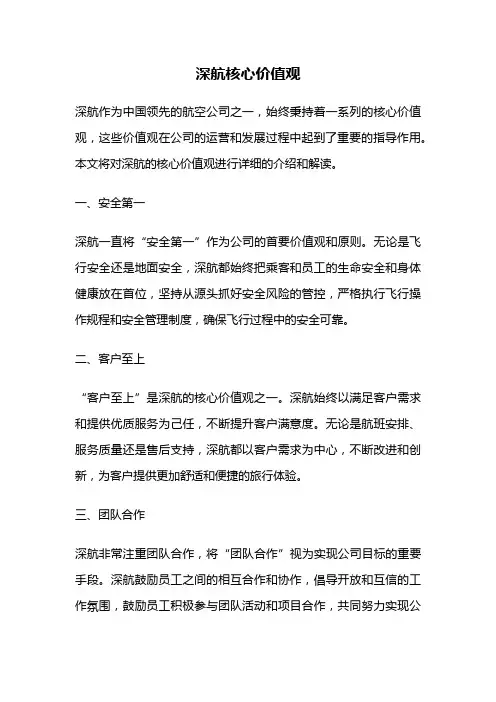
深航核心价值观深航作为中国领先的航空公司之一,始终秉持着一系列的核心价值观,这些价值观在公司的运营和发展过程中起到了重要的指导作用。
本文将对深航的核心价值观进行详细的介绍和解读。
一、安全第一深航一直将“安全第一”作为公司的首要价值观和原则。
无论是飞行安全还是地面安全,深航都始终把乘客和员工的生命安全和身体健康放在首位,坚持从源头抓好安全风险的管控,严格执行飞行操作规程和安全管理制度,确保飞行过程中的安全可靠。
二、客户至上“客户至上”是深航的核心价值观之一。
深航始终以满足客户需求和提供优质服务为己任,不断提升客户满意度。
无论是航班安排、服务质量还是售后支持,深航都以客户需求为中心,不断改进和创新,为客户提供更加舒适和便捷的旅行体验。
三、团队合作深航非常注重团队合作,将“团队合作”视为实现公司目标的重要手段。
深航鼓励员工之间的相互合作和协作,倡导开放和互信的工作氛围,鼓励员工积极参与团队活动和项目合作,共同努力实现公司的发展目标。
四、诚信守法深航坚持诚信守法,将“诚信守法”作为公司的基本准则。
深航坚决抵制任何形式的腐败和违法行为,建立健全的内部监督机制和合规体系,确保公司的运营和管理始终遵循法律法规和行业规范。
五、追求卓越深航一直追求卓越,在航空运输领域不断创新和超越。
深航鼓励员工勇于挑战自我,追求卓越的工作表现和个人成长。
深航致力于提供高品质的服务和产品,不断提升企业的核心竞争力,为乘客提供更好的飞行体验。
六、责任担当深航强调责任担当,将“责任担当”作为公司文化的重要组成部分。
深航要求员工勇于承担责任,积极履行岗位职责,保障航空运输的安全和顺畅。
同时,深航也积极履行社会责任,关注环境保护、社会公益等方面的问题,为可持续发展做出贡献。
七、创新进取深航鼓励创新进取,将创新视为推动公司发展的重要动力。
深航鼓励员工提出新想法和创新方案,倡导开放的创新文化,推动科技和管理的不断进步。
深航积极引进先进技术和管理经验,不断提升自身的核心竞争力。
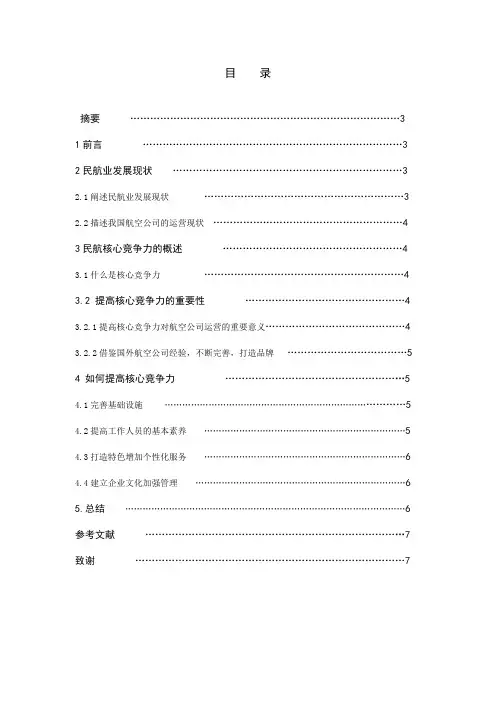
目录摘要 (3)1前言 (3)2民航业发展现状 (3)2.1阐述民航业发展现状 (3)2.2描述我国航空公司的运营现状 (4)3民航核心竞争力的概述 (4)3.1什么是核心竞争力 (4)3.2 提高核心竞争力的重要性 (4)3.2.1提高核心竞争力对航空公司运营的重要意义 (4)3.2.2借鉴国外航空公司经验,不断完善,打造品牌 (5)4 如何提高核心竞争力 (5)4.1完善基础设施 (5)4.2提高工作人员的基本素养 (5)4.3打造特色增加个性化服务 (6)4.4建立企业文化加强管理 (6)5.总结 (6)参考文献 (7)致谢 (7)浅析如何提高航空公司的核心竞争力摘要:我国民用航空在过去的20多年得到迅速的发展,行业规模和服务能力有了大幅度的提高。
另一方面,由于近年来宏观经济形势剧烈变化,各种不确定的因素增多,行业内竞争不断加剧。
现阶段,我国各大航空公司想要在此形势下依旧保持优势,力争上游,适应未来市场竞争的需要,并在激烈的市场竞争中生存与发展,关键取决于企业的竞争力。
提高企业竞争力成为当前摆在各家航空公司面前的一个亟待解决的问题。
关键词:核心竞争力;企业文化;加强管理;提高服务质量1 前言中国的航空企业正面临着机遇和挑战,如何利用当前的时机,尽早提高自身的实力,做好迎接挑战的准备,是我国各大航空公司的当务之急。
随着政府的支持和民航市场的逐渐规范,中国的民航业前景一定会更加光明。
2 民航发展现状2.1阐述民航发展现状世界各国对民航业都十分重视,虽然都懂明白是一个高风险的行业,但是依旧对其加以扶持。
民用航空业已经深刻的改变了人们的时空观念,航空运输是21世纪国家经济发展的驱动力、“发动机”。
通过民航业所聚集的人流、物流、资金流、技术流、信息流等优秀资源,对区域经济社会发展正在产生着强大的辐射效应,“临空经济区”、“航空大都市”已成为现代化国经济中心城市迅速崛起的重要依托。
以航空运输业为核心所形成的航空经济,已成为一种重要的新兴的重要形态。
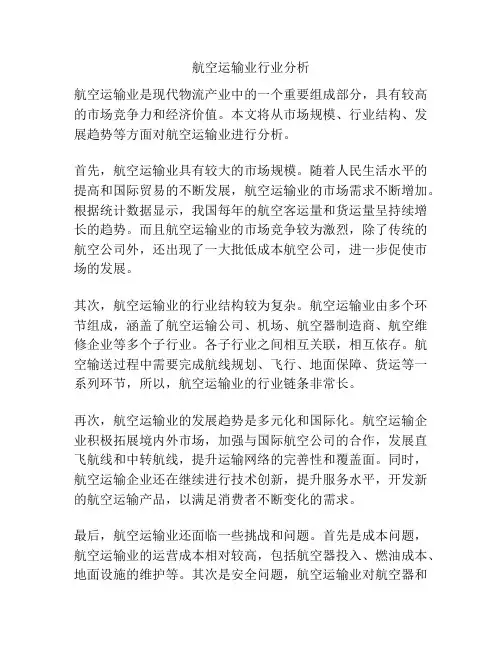
航空运输业行业分析航空运输业是现代物流产业中的一个重要组成部分,具有较高的市场竞争力和经济价值。
本文将从市场规模、行业结构、发展趋势等方面对航空运输业进行分析。
首先,航空运输业具有较大的市场规模。
随着人民生活水平的提高和国际贸易的不断发展,航空运输业的市场需求不断增加。
根据统计数据显示,我国每年的航空客运量和货运量呈持续增长的趋势。
而且航空运输业的市场竞争较为激烈,除了传统的航空公司外,还出现了一大批低成本航空公司,进一步促使市场的发展。
其次,航空运输业的行业结构较为复杂。
航空运输业由多个环节组成,涵盖了航空运输公司、机场、航空器制造商、航空维修企业等多个子行业。
各子行业之间相互关联,相互依存。
航空输送过程中需要完成航线规划、飞行、地面保障、货运等一系列环节,所以,航空运输业的行业链条非常长。
再次,航空运输业的发展趋势是多元化和国际化。
航空运输企业积极拓展境内外市场,加强与国际航空公司的合作,发展直飞航线和中转航线,提升运输网络的完善性和覆盖面。
同时,航空运输企业还在继续进行技术创新,提升服务水平,开发新的航空运输产品,以满足消费者不断变化的需求。
最后,航空运输业还面临一些挑战和问题。
首先是成本问题,航空运输业的运营成本相对较高,包括航空器投入、燃油成本、地面设施的维护等。
其次是安全问题,航空运输业对航空器和航空器制造商的安全要求较高,对于事故的处理和应对也存在较高的压力。
再次是环境问题,航空运输业对环境的污染较大,包括航空器排放的废气和噪音等,如何减少对环境的影响是一个亟待解决的问题。
综上所述,航空运输业作为现代物流产业的一个重要组成部分,具有较大的市场规模和市场竞争力。
在面临挑战和问题的同时,航空运输业也在不断发展和创新,通过技术创新和市场拓展,提高自身的竞争力和服务水平。
航空运输业的发展前景较好,然而需要针对行业内的问题和挑战进行进一步深入的探讨和研究。
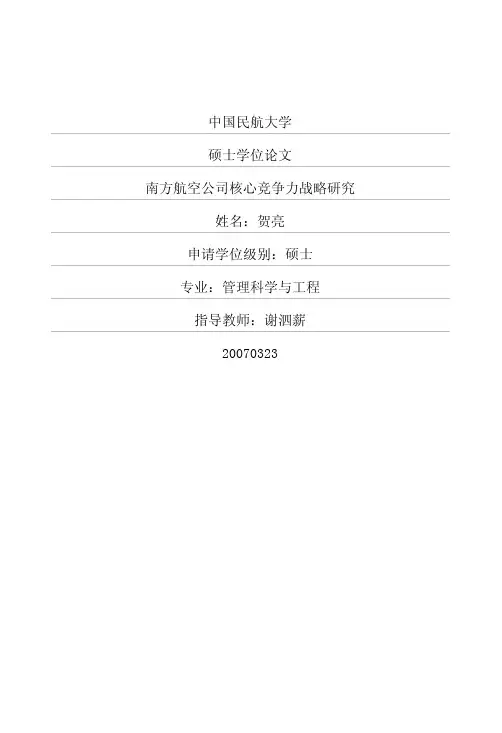

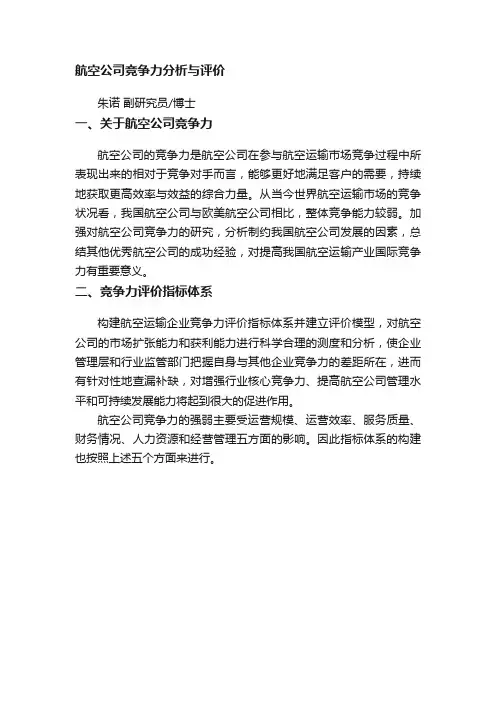
航空公司竞争力分析与评价朱诺副研究员/博士一、关于航空公司竞争力航空公司的竞争力是航空公司在参与航空运输市场竞争过程中所表现出来的相对于竞争对手而言,能够更好地满足客户的需要,持续地获取更高效率与效益的综合力量。
从当今世界航空运输市场的竞争状况看,我国航空公司与欧美航空公司相比,整体竞争能力较弱。
加强对航空公司竞争力的研究,分析制约我国航空公司发展的因素,总结其他优秀航空公司的成功经验,对提高我国航空运输产业国际竞争力有重要意义。
二、竞争力评价指标体系构建航空运输企业竞争力评价指标体系并建立评价模型,对航空公司的市场扩张能力和获利能力进行科学合理的测度和分析,使企业管理层和行业监管部门把握自身与其他企业竞争力的差距所在,进而有针对性地查漏补缺,对增强行业核心竞争力、提高航空公司管理水平和可持续发展能力将起到很大的促进作用。
航空公司竞争力的强弱主要受运营规模、运营效率、服务质量、财务情况、人力资源和经营管理五方面的影响。
因此指标体系的构建也按照上述五个方面来进行。
图1 网络型航空公司综合评价体系1.运营规模航空公司是资金、劳动力、燃油高密集型行业,其生产过程不可缺少飞机、飞行员、相关配套设备等,因此为使航空公司的持续运营成为可能,并在航空运输市场的竞争中占有一席之地,航空公司必须具备一定的生产规模。
航空公司的运营规模的二级指标可以从资产规模、机队数量、航班班次、航线数量等指标进行衡量和体现。
2.运营效率航空公司的运营效率是一个航空公司综合竞争力的关键指标,航空公司如何用最低的成产成本取得最大的收益,如何有效的利用有限的资源来实现全局利益的最大化,一直是航企所重点关心的内容。
其二级评价指标包含客座率、载运率、飞机日利用率、最短衔接时间等。
3.服务质量航空公司服务质量是指航空公司满足消费者明确或隐含需要能力特性的总和。
旅客对于航空公司的需求重点是保证航班安全、正常、中转便捷、办理各种手续快捷和乘机舒适。
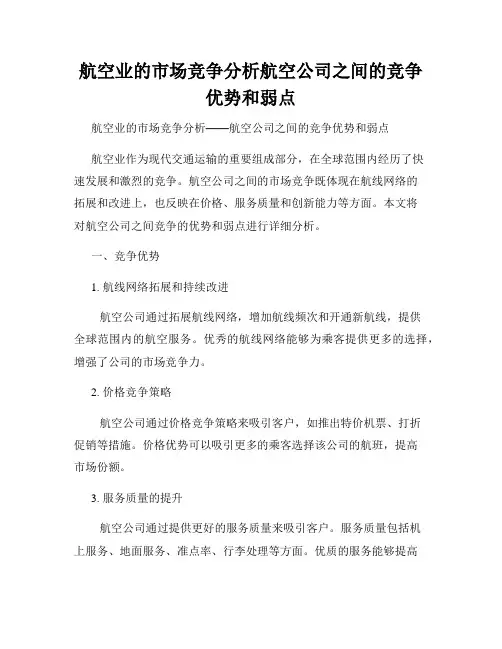
航空业的市场竞争分析航空公司之间的竞争优势和弱点航空业的市场竞争分析——航空公司之间的竞争优势和弱点航空业作为现代交通运输的重要组成部分,在全球范围内经历了快速发展和激烈的竞争。
航空公司之间的市场竞争既体现在航线网络的拓展和改进上,也反映在价格、服务质量和创新能力等方面。
本文将对航空公司之间竞争的优势和弱点进行详细分析。
一、竞争优势1. 航线网络拓展和持续改进航空公司通过拓展航线网络,增加航线频次和开通新航线,提供全球范围内的航空服务。
优秀的航线网络能够为乘客提供更多的选择,增强了公司的市场竞争力。
2. 价格竞争策略航空公司通过价格竞争策略来吸引客户,如推出特价机票、打折促销等措施。
价格优势可以吸引更多的乘客选择该公司的航班,提高市场份额。
3. 服务质量的提升航空公司通过提供更好的服务质量来吸引客户。
服务质量包括机上服务、地面服务、准点率、行李处理等方面。
优质的服务能够提高客户的满意度,增加客户忠诚度,对企业形象和市场竞争力有积极的影响。
4. 技术创新和数字化转型航空公司通过技术创新和数字化转型来提升自身的竞争力。
例如,引入先进的机载设备、在线购票系统、移动端APP等,提高客户的便捷性和舒适度,增强了公司的市场竞争力。
二、竞争弱点1. 品牌知名度和声誉在航空业竞争中,一些新兴航空公司可能面临品牌知名度和声誉的不足。
相对于传统大型航空公司,新进入市场的公司需要更多的时间和资源来建立品牌形象,提升公众对其的信任度。
2. 资金压力和成本管理航空业的运营成本较高,包括燃油费、机场费用、机组人员成本等。
一些航空公司可能面临资金压力,无法有效管理成本,影响市场竞争力。
3. 政策和法规限制航空业受到政策和法规的限制,包括航权分配、航线权限、航空安全等方面。
一些航空公司可能受到政府限制,无法开展某些航线和业务,限制了其竞争优势。
4. 环境和可持续发展压力航空业在发展过程中也面临环境和可持续发展的压力。
航空公司需要应对航空排放的控制要求,采取环保措施,以减少对环境的影响。
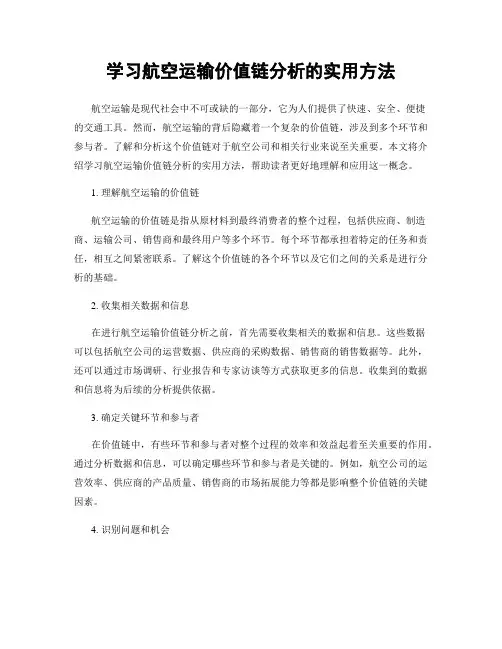
学习航空运输价值链分析的实用方法航空运输是现代社会中不可或缺的一部分,它为人们提供了快速、安全、便捷的交通工具。
然而,航空运输的背后隐藏着一个复杂的价值链,涉及到多个环节和参与者。
了解和分析这个价值链对于航空公司和相关行业来说至关重要。
本文将介绍学习航空运输价值链分析的实用方法,帮助读者更好地理解和应用这一概念。
1. 理解航空运输的价值链航空运输的价值链是指从原材料到最终消费者的整个过程,包括供应商、制造商、运输公司、销售商和最终用户等多个环节。
每个环节都承担着特定的任务和责任,相互之间紧密联系。
了解这个价值链的各个环节以及它们之间的关系是进行分析的基础。
2. 收集相关数据和信息在进行航空运输价值链分析之前,首先需要收集相关的数据和信息。
这些数据可以包括航空公司的运营数据、供应商的采购数据、销售商的销售数据等。
此外,还可以通过市场调研、行业报告和专家访谈等方式获取更多的信息。
收集到的数据和信息将为后续的分析提供依据。
3. 确定关键环节和参与者在价值链中,有些环节和参与者对整个过程的效率和效益起着至关重要的作用。
通过分析数据和信息,可以确定哪些环节和参与者是关键的。
例如,航空公司的运营效率、供应商的产品质量、销售商的市场拓展能力等都是影响整个价值链的关键因素。
4. 识别问题和机会通过对数据和信息的分析,可以发现价值链中存在的问题和机会。
问题可能包括供应链延迟、运输成本过高、销售渠道不畅等。
而机会则可能包括新的市场需求、技术创新、合作伙伴关系等。
识别这些问题和机会将为后续的改进和优化提供方向。
5. 制定改进策略基于对问题和机会的识别,可以制定相应的改进策略。
例如,对于供应链延迟问题,可以考虑优化供应商的配送流程;对于运输成本过高问题,可以考虑采用更加节能环保的飞机;对于销售渠道不畅问题,可以考虑与电商平台合作等。
制定改进策略需要综合考虑成本、效益、可行性等因素。
6. 实施和监控改进措施制定好改进策略后,需要进行实施和监控。
航空运输系统组成与范畴1. 引言航空运输系统是现代化社会不可或缺的一部分,它是由各种组件和机构组成的庞大系统。
本文将对航空运输系统的组成和范畴进行详细的介绍。
2. 航空运输系统的组成航空运输系统由多个关键组成部分构成,包括飞机、机场、航空公司和航空管制。
下面对每个组成部分进行详细的介绍。
2.1 飞机飞机是航空运输系统的核心组件,它被用于在空中运输乘客和货物。
不同类型的飞机适用于不同的任务,如客机、货机、直升机等。
飞机的设计和制造需要经过严格的安全标准和审查程序,以确保其安全性和可靠性。
2.2 机场机场是航空运输系统中的地面基础设施,用于起降飞机、停放飞机和提供乘客出入口服务。
机场通常包括跑道、停机坪、候机楼、行李处理设施和航空燃油供应设施等设施。
机场需要满足一系列安全标准和航空运营要求,以确保安全和顺畅的空中运输。
2.3 航空公司航空公司是航空运输系统中的运营实体,负责运营和管理飞机、机场和空中乘客服务。
航空公司的职责包括飞行计划、机组人员管理、票务销售、乘客服务和货物运输等。
航空公司需要遵循相关法规和国际航空协定,以确保航空运输的安全和可靠性。
2.4 航空管制航空管制是航空运输系统中的重要环节,负责监控和协调飞机的空中和地面运行。
航空管制机构通过雷达、通信系统和航空电子设备等手段,实时监视飞机位置和航行情况,并向飞行员提供导航和通信指导。
航空管制的目标是保持飞机之间的安全间隔,确保航空运输的顺利进行。
3. 航空运输系统的范畴航空运输系统的范畴涵盖了几个方面,包括乘客运输、货物运输和航空运输服务。
下面将对每个范畴进行详细介绍。
3.1 乘客运输乘客运输是航空运输系统的主要功能之一,它提供便捷的空中交通服务,使乘客能够快速地到达目的地。
乘客运输通常包括定期航班和包机服务,乘客可以根据需要购买机票,并在指定的时间和地点登机。
航空公司提供各种舱位类型和服务水平,以迎合不同乘客的需求。
3.2 货物运输货物运输是航空运输系统的另一个重要功能,它通过空运方式将货物从一个地方运送到另一个地方。
航空货运市场竞争研究与优化随着全球贸易的迅猛发展,航空货运市场日渐火爆。
航空货运业成为各国经济互联互通的重要桥梁,起着极其重要的作用。
面对竞争激烈的市场环境,航空货运企业必须进行市场竞争研究与优化,以确保自身的竞争优势和持续发展。
首先,我们需要进行航空货运市场竞争研究,以了解市场的整体情况和各竞争对手的特点。
航空货运市场的竞争格局是一个复杂而多变的系统,需要综合考虑各种因素,如市场需求、价格竞争、运输时效、服务质量等。
在市场需求方面,要分析航空货运市场的潜在需求和实际需求。
潜在需求是指潜在的市场容量,可以通过分析各行业的进出口贸易情况、国内外市场的发展趋势等来预测。
实际需求是指市场上已经成交的货运量,可以通过市场调研、分析竞争对手的市场份额等来了解。
在价格竞争方面,要研究市场上各竞争对手的定价策略和价格变动趋势。
航空货运市场的价格竞争非常激烈,企业需要找到适当的价格定位,既要保持一定的利润空间,又要能吸引客户。
在运输时效方面,航空货运企业需要提供快速、准时的货运服务,以满足客户的需求。
通过研究竞争对手的运输时效和服务水平,航空货运企业可以进行优化,提高自身的运输效率。
在服务质量方面,航空货运企业需要关注客户的满意度和忠诚度。
通过研究客户的需求和反馈,企业可以不断优化自己的服务,提升客户体验,赢得客户的长期支持。
了解市场竞争的情况后,航空货运企业需要进行优化,提升自身的竞争力。
首先,企业可以通过创新来寻求突破。
比如,引入新的运输技术、改进运输流程、提供定制化的运输解决方案等。
创新可以帮助企业开拓新的市场、提高运输效率、降低运营成本。
其次,企业可以通过加强合作与联盟来提升竞争力。
航空货运企业可以与其他企业建立战略合作关系,共享资源、互补优势,提高整体的市场份额和竞争力。
此外,航空货运企业还可以与相关行业进行跨界合作,打造全球化的货运网络,提供全方位的物流服务。
此外,航空货运企业还应关注科技的应用。
航空货运业是一个依赖技术的行业,通过科技的应用可以提高运输效率、降低运营成本。
航空公司的竞争优势与盈利模式研究随着全球经济的蓬勃发展和人们生活水平的提高,航空业在过去几十年中得到了快速的发展。
航空公司作为行业的核心参与者,不断追求竞争优势和盈利模式的创新。
本文将从航空公司竞争优势的角度出发,分析其盈利模式的研究,以及如何实现可持续发展。
一、航空公司的竞争优势1. 低成本运营模式航空公司面临着诸多经营成本的挑战,包括航油价格波动、机队维护、人力成本等。
低成本运营模式成为航空公司竞争优势的重要组成部分。
通过有效的成本控制和优化运营流程,航空公司可以为乘客提供更具竞争力的票价,并在市场上获得更大的份额。
2. 航线网络和航班频次航空公司的航线网络和航班频次对于吸引旅客和提高市场份额至关重要。
航线网络的规模和便利程度,能够直接影响旅客选择航空公司的决策。
航空公司通过不断扩大航线网络和增加航班频次,提供更多的选择和更方便的航班安排,从而获得竞争优势。
3. 服务质量和客户满意度航空公司竞争优势的一个关键因素是服务质量和客户满意度。
通过提供舒适航班环境、品质化的餐食和卓越的客户服务,航空公司可以树立良好的品牌形象和声誉,吸引更多的乘客选择他们的航线。
同时,航空公司还可以通过积极的市场推广,加强与客户之间的关系,提高客户满意度并长期留住客户。
二、盈利模式的研究1. 主要盈利来源:票价和附加服务航空公司的主要盈利来源是票价收入和附加服务收入。
票价收入是航空公司从乘客购买机票中获得的收入,而附加服务收入则包括行李托运费、餐食销售、座位升级等额外服务的收入。
通过灵活的票价策略和个性化的附加服务,航空公司可以提高盈利能力。
2. 成本控制和提高效率为了实现可盈利模式,航空公司需要严格控制成本并提高运营效率。
航空公司可以通过有效的供应链管理、电子化操作流程以及合理安排机组人员和飞机资源,降低成本,提高效率。
同时,技术的应用和自动化的操作也可以帮助航空公司降低运营成本。
3. 不断创新和多元化经营在不断变化的市场环境中,航空公司需要不断创新和多元化经营来扩大盈利模式。
我国航空公司竞争优势评价与分析【摘要】我国航空公司在激烈的市场竞争中扮演着重要角色,具有明显的竞争优势。
本文从我国航空公司的发展现状入手,分析其竞争优势构成要素和评价方法,进而深入探讨其竞争优势的现状及分析。
也探讨了我国航空公司面临的挑战与机遇。
在对我国航空公司竞争优势进行总结的基础上,提出了未来发展建议。
通过研究这些内容,可以更好地了解我国航空公司的优势和劣势,为其未来发展提供参考。
【关键词】关键词:我国航空公司、竞争优势、评价、分析、发展现状、构成要素、挑战、机遇、总结、未来发展建议。
1. 引言1.1 研究背景我国航空业自改革开放以来取得了长足的发展,航空公司数量逐渐增多,航线网络不断完善,业务范围不断扩大,服务品质不断提升。
随着中国经济的快速发展,国内航空市场需求不断增长,竞争日益激烈。
在这种背景下,我国航空公司要想在市场上脱颖而出,就必须具备一定的竞争优势。
航空公司的竞争优势是其在市场竞争中取得成功的关键因素,也是其能够长期生存和发展的基础。
对我国航空公司竞争优势进行评价和分析,对于提升我国航空公司的核心竞争力具有重要意义。
通过对竞争优势的评价分析,可以帮助航空公司更好地把握市场需求,制定更科学的发展战略,提高市场竞争力,实现可持续发展。
本文将围绕我国航空公司竞争优势的评价与分析展开研究,旨在深入探讨我国航空公司的发展现状、竞争优势的构成要素、评价方法以及面临的挑战与机遇,为我国航空公司未来发展提供参考依据和建议。
1.2 研究目的研究目的是对我国航空公司竞争优势进行全面评价与分析,旨在探讨我国航空公司在当前国际竞争环境中的地位和优势所在,以便为我国航空业的发展提供有效的指导和建议。
通过研究航空公司的发展现状、竞争优势的构成要素、评价方法和分析,可以更深入地了解我国航空公司的竞争优势来源和优势地位,为航空公司提供提升竞争力的战略思路和方法。
研究我国航空公司面临的挑战与机遇,有助于预测未来发展趋势并制定相应的发展策略。
Capital University Of Economics and Business硕士学位论文Thesis for Degree Of Master论文题目:货运航空企业的核心竞争力关键要素研究一以A货运航空公司北京基地为例专业:企业管理1 00177作者:曰谷指导教师:张晗副教授完成时间:2015年3月首都经济贸易大学硕士学位论文THESI S OF DOCTOR (MASTER) DEGREE论文题目:货运航空企业的核心竞争力关键要素研究一以A货运航空公司北京基地为例工商管理学院指导教师:张晗完成日期: 2 01 5· 3.2独创性声明本人郑重声明:今所呈交的《货运航空企业的核心竞争力关键要素研究一以A货运航空公司北京基地为例》论文是我个人在导师指导下进行的研究工作及取得的科研成果。
尽我所知,文中除了特别加以标注和致谢的地方外,论文中不包含其他人已经发表或撰写的内容及科研成果,也不包含为获得首都经济贸易大学或其它教育机构的学位或证书所使用过的材料。
名日期:阝年《月下日关于论文使用授权的说明本人完全了解首都经济贸易大学有关保留、使用学位论文的有关规定,学校有权保留送交论文的复印件,允许论文被查阅、借阅或网络索引;学校可以公布论文的全部或部分内容,可以采取影印、缩印或其它复制手段保存论文。
(保密的论文在解密后应遵守此规定)作者签名‰导师签名、日期:了年了月犭日摘要随着中国进入WTO以来,中国的经济发展速度迅猛。
更多的外国航空公司争相进入中国航空市场,国内的航空货运企业和快递企业也相继成立。
本文是以现阶段中国航空货运市场竞争激烈,国内航空货运企业普遍不景气的背景下重点分析研究了航空货运企业如何发展提升自身国际竞争力。
在借鉴国内外航空货运企业己有的企业战略发展上,以中国A 货运航空有限公司北京运营基地为例,运用SWOT分析法,通过对 A货航北京运营基地内部的优势和劣势,以及其面临的外部机遇和挑战的现状进行分析比较,找出自身存在的问题和差距及产生这种不足的原因。
Market competition in the market continue to promote resource allocation at the same time, also make competitors through restructuring, allocation and integration of internal resources to the market resource allocation has reasonable share and effective advantage. Air transport of fierce competition in the market in a certain social positive effect at the same time, also to the air transport enterprises and puts forward the most serious challenge.Face the competitive pressure of the market, a number of aviation transportation enterprises begin to adjust business strategy. For example, in the flight application, product promotion, the introduction of large models, develop new markets and other aspects, hoping that through the adjustment of strategy to attract and stabilize tourist market. In fact, these strategy adjustment or redistribution of resources around the aviation transportation enterprises should possess and the core competitive power to begin.Competitiveness is aviation transportation enterprises in market competition for resources allocation of basic survival skills, and aviation transportation enterprises operating on the basis of ability. The competitiveness of a variety of factors, but not every kind of factors are able to become competitive advantage. Advantage competitiveness depends on the air transport enterprises in market competition the effectiveness and aviation transportation enterprises can in the competition from competitors and enables companies to enter benign development of multiple function embodiment. In a certain sense, competitiveness and competitive advantage is the relative market development and competition changes in specific period reflected a kind of advantage or ability, along with changes in external factors and internal factors of the interference, even if the competitive advantage will be the environment changes in only a kind of ability to survive, for aviation transportation enterprise's long-term strategic development, these abilities can only play a role in a short period of time, are not enough to maintain air transport enterprises sustainable development strategy. How to maintain the sustainable development of aviation transportation enterprises, in order to determine the dominant position in the market competition? Construction of core competitiveness is aviation transportation enterprises in production and operation management process to face an important task. Core competitiveness is more concerned about the long-term development of enterprises, competition in the market in essence different from competitors and the market resources of motive power.One, the concept of core competence and characterCore competence is the enterprise organization capital and social capital of the collection, organization capital refers to the organization to assume the task of the coordination of the assets, and social capital refers to the resources available to people used to obtain the income that part of the value of social structure, it acts through the people of mutual relations between the change of organizational capital; " reflects the coordination and organization of production technology, social capital has shown the importance of social environment ", which can be embodied in the organizational structure, the latter can reflect enterprise culture.For air transport enterprises core competitiveness, aviation transportation enterprises core competitiveness should be based on the value chain of the industry as the basis, is one of the internal core resource ( technical ability, organization coordinated ability, market ability of meeting an emergency and innovation etc) recombination and assigned to maintaining and enhancing continuous profits as the goal, to external resources coordination and with each associated party to meet the interest distributive complete operating system, and through the effective operation of the system to their own unique competitive advantage in stability and expansion of the market gains to achieve air transport for the long-term development strategy.Two, to build the core competence in the action in practiceAir transport enterprise development in the presence of multiple sources of competition, the scale ranging from aviation company in the market competition to construct and establish different development way.Air transport enterprise presents these features, not a single factor can be generated, around the construction of core competitiveness among many factors, due to different factors combined to produce a different management strategy and tactics, but also bring different air transport enterprises of different management efficiency and market positioning. Air transport enterprises around the market operation, but not every air transport enterprises to construct and build its own brand core competitiveness. Construction of core competitiveness and not accomplish at one stroke, it is related to the internal scientific, effective management, relationship to the enterprise culture correctly, is related to the external social environment on which it made the effect evaluation and so on many aspects. But the establishment of core competitiveness will no doubt make enterprise take the last scientific, healthy development track, in the operation of the market will take it leisurely and unoppressively, winning a thousand miles.Three, to build the core competence of the key elements of the value analysisAs mentioned, there are a lot of factors consisting of the competitiveness of enterprises, but in a lot of factors only a few of the key factors in combination, can realize the enterprise 's overall efficiency and effectiveness. This article tries from the internal and external environmental factors, based on the enterprise value chain perspective of aviation transportation enterprises core competitiveness factor analysis.The internal factors in the development and change of enterprises is the survival and competitive power. From Michael Potter's value chain theory we can see in the value chain of enterprise system, is divided into two parts the behavior, whereby the auxiliary and main behavior behavior. The auxiliary acts constitute a basic enterprise production operation, carry out the market activity security. Adjunctive behavior established mainly around can bring more benefit and social value of the main behavior of. That is to say, the enterprise supplementary behavior and main complement each other, can play the efficacy, adjunctive behavior is the basis, main behaviour is benefit. Only based on the auxiliary acts on the main behavior can enterprises survival value, but also to create more business value and social value.Based on the enterprise value chain theory, combined with air transport enterprises external environment characteristics, composition of aviation transportation enterprises core competitiveness factors mainly include:( a ) the human resources especially the development and application of human resourcesEnterprise's development is inseparable from the cultivation and development of talents. As a result of air transport enterprises unique profession characteristic and the demand, the demand for talent is mainly concentrated in the flight, aircraft maintenance, flight dispatching and other fields, the field of personnel training and absorption of air transport is essential for the normal operation of enterprises is the key link, the aviation transportation enterprise safety in production and development of the cornerstone. On the value chain theory, this kind of talented person belongs to the auxiliary behavior unit talented persons. With the modern enterprise management mechanism and development, aviation transportation enterprises begins talent focus from adjunctive behavior unit turned to the operation and development of enterprises to bring lasting benefits, enterprise value chain in the main unit of the marketing department.In the management of human resources, the human resources department of enterprise development is the baron. Human resources department functions have been infiltrated into the company's strategic planning and development, into the managemant decision of the enterprise, for the enterprise development training, screening, and selected a variety of talents, and the appropriate personnel transport into the right job.In the talent screening and post deployment, have a scientific, strict management process, namely, establish and perfect the system of employee occupation career design. Talents have classes and functions of points, as the human resources department of the company as a designer, different materials used in different places. In the personnel division should have a key distinction, namely human resources, human resources and labor resources in. Different positions have different demand for talents, the most easy to let the human resources department to ignore is the resource development and application. Along with the development of aviation transportation enterprises market competition intensifies, the world different Airlines began to focus on the marketing department of human resources development, so as to realize the enterprise in the marketing strategic development goals and to create more value. Harntha airlines, British Airways, Singapore Airlines airlines and other well-known in the cultivation of talents is not only the recruitment of flight, aircraft repair and other fields have experienced talents, pay more attention to the marketing of human resources development, absorb and cultivate a group of professional, business and strong in high even the doctor, in the marketing strategy of the company of the development put forward many constructive solutions.( two) information technology development and application abilityWith the development and popularization of the information technology industry, the aviation transport enterprise informatization demand is more and more high. The development of information technology and application already became the airtransport enterprises to enter the market of china. Information technology has not only confined to the internal exchange of information and statistics, it has become the air transport enterprises to enter the International Air Transport Association beachhead global market important carrier.Aviation industry the development of information technology trends and characteristics for:1, broadly speaking, refers to the aviation transportation enterprises to use modern information technology, the establishment of a set of applicable to the enterprise infrastructure operation and network. The enterprise through the network and each subsidiary body and external organization for information exchange and communication, and according to the feedback information to take corresponding actions and measures. In this sense the aviation industry information technology, including the navigation system, dispatch release system, marketing system, human resources management system, financial accounting system and many more related to air transport enterprise operates the information network; in a narrow sense, refers to the air transport enterprises by using information technology, to establish a set of improve the marketing and operation of the network system. Through the network system to collect and transmit some of market behavior of enterprises related information, and the information analysis and processing, make the enterprise in the market operation of decision-making.2, air transport enterprises in the development of the market potential, comprehensive application of aviation equipment, human resources and other aspects, the information technology and network dependence on more bonus. Information technology on air transport enterprises mature development plays an irreplaceable role, while the information network to enable the expansion of aviation transportation enterprises route layout from a limited area expansion and extension to another with a potential of the region, in the market development, operation and other aspects of route layout, cost, perfect information the network to air transport enterprises to provide an intuitive, efficient operation data. Through scientific analysis and assessment information often become aviation transportation enterprises dominate the market a main decision-making basis. United Airlines, Singapore Airlines and Lufthansa Airlines will become the main representative.3, information technology development and application promotion of aviation transportation enterprises market resources to rational use. Air transport enterprise should be directed to the industry operating characteristics, human organizations market information network development, establishing a set of scientific, reasonable market information network system. The information network system should include the customer to airline information, airlines or between other organizations for cooperation between the operation of the project information, to track the effectiveness, assessment and calculation and internal resource sharing and other basic content. System should focus on the inter-regional development to become a network of air transport market.In 4, along with the aviation market development, the integration of the global aviation market is growing, the major airlines to join to form some larger airline alliance. Thealliance between airlines to expand the regional market development and sales network, the development of information technology has become the key factor of the alliance benefit. The development and design of new information network platform, between airline alliance in information sharing, equipment sharing, shared, airline cooperation gambling public house long, effective use of the company's capacity, to avoid the operation activities into the waste caused by, thus saving the company's operating costs. Air transport association is the trend of globalization, it is the cornerstone of airline brand effect.( three) fleet planning and network scaleFleet planning and the introduction of aviation transportation enterprises the main investment, is the main consideration factor cost budget. To a certain extent, models and the introduction of operation is directly related to the survival and development of aviation transportation enterprises, scientific and reasonable fleet planning is aviation transportation enterprises to enter the market competition, expand the regional and global market key factors.Fleet planning is not only one kind of introduction and investment, but the company 's strategic development play a decisive role, fleet planning become the cost of aviation transportation enterprises strategy and marketing strategy is the key link, mainly has the following several aspects of the characteristics of:1, the market value and the choice of location decision model type, influence of marketing strategy company hardware support;2, the market environment of multiple variables determine the type of input and transportation arrangement;3, marketing strategy for the regional market and global market decision supporting a variety of models in the partition of market operation, the company marketing strategy development and formulation for models of planning a complete implementation plan and programme;4, fleet planning focused on cost leadership strategy, in aviation material supply, fleet maintenance, personnel training and so on more prominent its cost advantage;5, dimensions changes development highlight the fleet introduction and market demand closely, is the introduction of the latest hardware facilities and market demand closely and become the source of competitive advantage;In 6, the updated models, rent, retired should fully consider the market economy environment requirements, continuously updated models become some strength of aviation transportation enterprises competitive a magic weapon.Network planning and design involves a variety of factors, including the boat authority control, route geography environment decides to apply the models, and the competitor's competitive strategy, and strategy alliance network and so on many kinds of factors, route network planning to become air transport enterprise marketing strategy the important component, is the important resources of revenue management.The route network structure design and adjustment should fully consider the marketing effectiveness. As the models of the growth and the expansion of the market, the route network structure began to show a variety of changes. From the linearstructure into an annular structure, from the sector structure into spoke structure, from its route structure into a shared route structure. Route network structure and air transport enterprise resource structure. Gauge model network structure has become the competitive advantage important link.( four) enterprise management and capital operation capacity;Modern enterprise management and operation of an enterprise to have scientific definition. Organizational structure design, personnel allocation, process design and re-engineering, process monitoring and feedback, the leadership function of transformation and so on to establish a well-functioning business critical.Enterprise management in the formulation of policies and the marketing strategy at the same time, attention should also be paid to capital operation ability.Enterprise policy change in the listing Corporation's financing, investment will bring certain influence. The traditional mode of operation of the capital is aviation transportation enterprises how to expanded reproduction ability, in fixed asset investment, appreciation and value has done a number of follow-up development efforts.But with the rapid development of economy, the capital operation is also expanding. In addition to the main business to expand within the production investment at the same time, a number of aviation transportation enterprises is gradually expanding in the main business of the capital investment and operation, so that the air transport, tourism, catering, entertainment and other com., thereby reducing the cost of loss and bring the whole value chain benefit received a total of. With the aggravation of the market competition and the aviation business right restriction, by route control caused by capital market in the new field of flow and expansion. The competition of aviation enterprises, investment shares, holdings and so on, to a great extent broke through the air rights restrictions, the change of the regional air transportation market competition pattern.Capital penetration has also been expanded to the Union transport enterprise cooperation, through equipment sharing, personnel sharing, network sharing, information sharing, resource sharing, to strengthen the alliance competition ability, in the worldwide scale ranging from capital operation body form. In a certain sense, an air transport enterprise capital operation ability reflects a business decision of enterprise and market income level, is the senior management of the major test.( five) marketing development and innovation abilityMarketing and sales are the main activities of an important link, to the enterprise cash flow and return water。